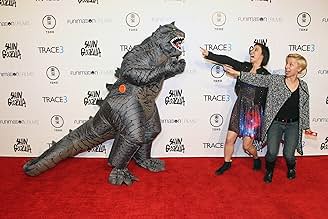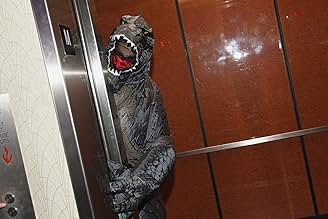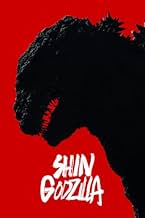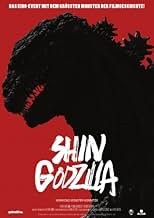Something has surfaced in Tokyo Bay. As the Prime Minister of Japan pleads with the public to remain calm, a horrific creature of tremendous size makes landfall in the city, leaving death an... Read allSomething has surfaced in Tokyo Bay. As the Prime Minister of Japan pleads with the public to remain calm, a horrific creature of tremendous size makes landfall in the city, leaving death and destruction in its wake. Then it evolves.Something has surfaced in Tokyo Bay. As the Prime Minister of Japan pleads with the public to remain calm, a horrific creature of tremendous size makes landfall in the city, leaving death and destruction in its wake. Then it evolves.
- Directors
- Writers
- Stars
- Awards
- 13 wins & 10 nominations total
- Directors
- Writers
- All cast & crew
- Production, box office & more at IMDbPro
Featured reviews
This is a roller-coaster ride plenty of destruction , wreak havoc , action-packed , thrills , chills and breathtaking scenes . Fun moments and frightening entertainment when happens appearance Godzilla carrying out an extreme mayhem , confusion and destruction . As Japan is plunged into chaos upon the appearance of a giant monster, then the cabinet sends a defence force to eliminate the monster but it evolves and starts inadvertently overheating with radiation and this causes the monster to run back to the bay, leaving a risk of returning to the cabinet . Based on the original Godzilla , any other bigger-than-life tale that span almost 60 years would have to answer some serious question about plot repetition . Fantastic design creature , being well and brilliantly made by means of state-of-art digital efects .The motion picture was competently directed by Hideaki Anno, Shinji Higuchi . Finale leaves door open for an inevitable follow-up but still no realized.
Other movies about the Japanese monster, always produced by Toho productions and with rubber suits, miniature sets, are the following ones : the classic ¨Gojira¨ (1955) or ¨Godzilla King of the monsters¨ by Inoshora Honda ,commercially hit in the US , being one of the first post-WWII Japanese film to break American boxoffice including ridiculously primitive FX even in its own day ; ¨Godzilla king of the monsters¨(1956); ¨Godzilla raid again¨(1959); ¨Godzilla vs the sea monster¨(1966) Jun Fukuda; ¨Godzilla on mosnter island¨ (1972) , ¨Godzilla vs Smog monster(¨72) , ¨Godzilla vs Biollante¨ , ¨Godzilla vs King Ghidora¨, ¨Godzilla Vs Monster Zero¨ , ¨ Godzilla vs Megalon¨(1976); ¨Godzilla¨ (1985) , ¨Godzilla vs Megagodzilla¨(1993); ¨Godzilla revenge¨, ¨Godzilla 2000¨....
The film is a modern-day remake, showing how would the Japanese government (and to an extent other governments) react if Godzilla showed up for the first time today. This film is one of the more politically-charged entries in the franchise and is more of a thriller than a straight-up monster movie. There are lots of characters, a majority of which don't have much personality, but the main ones like protagonist Rando I found myself latching on to. Some the best scenes are when the characters stop acting like politicians and have casual and occasionally humorous dialogue. At least they took the whole situation very seriously with rarely an over-the-top moment much like the 2014 film, a breath of fresh air within the franchise. There's also this mystery element that plays a huge part in the story which I liked very much. Just as the 1954 film was a metaphor for Hiroshima and Nagasaki, this one reflects the Fukushima meltdown as well as the tsunami and earthquake Japan suffered a few years back (goes to show that Godzilla will always find a way to stay relevant).
How does Big G himself hold up? Pretty good. His design is more-or-less an update of his original 1954 look, his skin looking like radiation scars. New to the series is that Godzilla EVOLVES throughout, starting out smaller and very odd-looking but growing larger, more powerful, and even smarter as the story progresses, making him unpredictable. I also enjoyed the exploration of his biology, that is how this creature could exist. My complaints fall under a few things, strictly on his main form: his arms are too small and he isn't very expressive, mostly just lumbering along in a straight line. When he does gets mad, however, that's when he really shines. The action scenes are entertaining enough and there's plenty of destruction featured with some surprising moments here and there. The special effects are largely CGI with elements of practical effects, both of which are good; Big G isn't a man in a suit this time (kinda disappointing) but rather motion capture, though there are a few well-done miniatures. Some sound effects are of the old era and the music is a mix of the original's by Akira Ifukube with some new ones by Shiro Sagisu, a lovely combo. There's even a track from Evangelion (Decisive Battle).
My favorite scene: The first time Godzilla uses his atomic breath. Set at night with a mournful choir singing in the background (w/ English lyrics), the suspense that builds to the monster unleashing his power and rage upon the world was epic, chilling even, and has tremendous payoff. It's a truly apocalyptic image.
There are a few issues to address. I admit the pacing isn't the best. The beginning particularly has some rapid editing and there are texts on the screen throughout (often naming a character and political position) that are quite distracting and take getting used to, though I suppose you're supposed to feel as rushed as these politicians. Also, there's a huge gap before the climax where there's no action going on that I honestly think the filmmakers should have cut down a little. I like the characters and what's happening to them, but I would have preferred for the film to cut to the chase a bit.
Overall, this movie has its faults for sure, but I'm still glad I saw it. It was an interesting twist to my favorite fictional character. More films in both Japan and America are on the way and I can't wait. Long live the King of the Monsters!
At present in Japan, there is an ongoing debate as to whether or not Japan should amend it's constitution to allow for an offensive military and this Godzilla film plays to exactly how powerless Japan would be in making it's own decisions during an attack of any kind. The reality is that the Japanese Prime Minister would have to ask for permission from the United States President before making an offensive move against a foreign threat and this film plays to that hard reality.
This new Godzilla starts out as an homage to its former man in a monster suit so that when you first see Godzilla, you'll disbelieve what you're seeing, but this Godzilla evolves into something majestic and utterly awe inspiring in its power.
What's more, this film makes it clear people die. In the Japanese release there's a lot of word play about how the government officials up high (on the fifth floor) make decisions that get passed down to people on lower floors that eventually hurt the people. I'm not sure how much will be translated, but the film is deliberately showing the disconnect between the political and day to day realities.
Overall, the performances are good. There is one character who they, for whatever reason, decided to make speak English in odd an inappropriate times.
This isn't a film for US audiences. The aesthetics will turn off a lot of non-Japanese young people accustomed to CG reality. But if you're open to learning about another culture, this is an excellent film, one of the best kaiju-films you'll ever see.
No other recent event has been so seared in the Japanese consciousness as that of the 2011 Tohoko earthquake and tsunami as well as the consequent Fukushima nuclear disaster, not just because of the hundreds of thousands of people affected but also because it exposed how terribly unprepared the Japanese government was with handling a crisis of such proportions. The parallels here are unmistakable – from an indecisive Prime Minister (Ren Ôsugi) to the frustratingly bureaucratic attitude of his Cabinet ministers to the embarrassing revelation of his poor judgment (such as during a live press conference where Godzilla makes landfall right after he specifically tells the people that the creature will not) – and indeed meant no less than a searing indictment of just how inept the Naoto Kan's administration was during 3/11.
Yet it isn't hard to imagine how a movie based solely on such criticism would quickly turn monotonous, not least because the lead characters here are all political/ Government figures – among them, Hiroki Hasegawa's outspoken and gutsy Deputy Chief of Cabinet Secretary Rando Yaguchi, Yutaka Takenouchi's opportunistic Aide to the Prime Minister Hideki Akasaka, and Satomi Ishihara's Special Envoy for the United States Kayoko Ann Patterson – and each is defined only in terms of his or her role and ambition in relation to the ongoing calamity. None too subtle is the point, emphatically and unequivocally made, that while politicians wield the ingenuity and authority it takes to manage an unprecedented catastrophe, each is also simultaneously weighting the cost or opportunity of every decision or maneuver to his or her political futures.
Just as illuminating, especially to the Japanese, is the strengths or limits of its military might post-WWII, seeing as how it has never yet seen the need to invoke the use of its Self-Defense Forces (SDF) or call in the help of the US military under the US-Japan Security Treaty. Under the pretense of exterminating Godzilla, Anno's screenplay imagines what it would take not just for the SDF to be activated but also how US intervention would likely come with some strings attached. How and if at all it is meant to play into the current Shinzo Abe's push for an expansion of the SDF role is quite perceptively left up to the audience's interpretation, but there is no doubting that the introduction of the United Nations late into the film is meant to demonstrate how powerless nations not on its Security Council may be to resolutions passed by its five members on non-member countries.
Yes, if it isn't yet clear, there is no intent here to highlight the human dimension of such an event; rather, it is domestic politics as well as the global world order that forms the basis of this re- incarnation of Godzilla. As a reboot, 'Shin Godzilla' starts on a clean slate, beginning with an underwater disturbance that briefly makes its way onto shore before going back out to sea, then returning as a much more highly evolved organism that grows and grows ever more fearsome. Fans though will not be disappointed – as with past iterations of Godzilla, this latest version not only has the ability to radiate highly destructive atomic rays from its dorsal fins, it also can set streets of buildings ablaze by spewing fire out of its mouth. It does take time to get used to the new 'ShinGoji' design, but rest assured that this beast is every bit as terrifying as it should be.
In fact, that palpable sense of fear is twofold – first, in tying the origins of Godzilla to Japan's ignominious nuclear history; and second, in showing with utmost realism the wanton destruction of notable landmarks in Tokyo by the monster. The former has to do as much with the United States' alleged dumping of radioactive waste in Tokyo Bay in the 1950s and 1960s as accusations of Japan's own disposal of toxic ash from the burning of Fukushima's nuclear waste into the same waters. The latter, on the other hand, sees entire districts in Tokyo ripped or flattened by Godzilla's rampage, impressively staged by co-director cum VFX supervisor Anno (also known for last summer's 'Attack of Titan') using a mix of old- fashioned puppetry and modern CGI. In particular, the combined US- Japan military assault on Godzilla along the banks of the Kano River and the finale in downtown Shinjuku is stunning, especially in imagining the magnitude of destruction that Godzilla could inflict on modern-day Japan.
Yet if the promotional materials have given the impression that 'Shin Godzilla' is an action-packed blockbuster like its most recent Hollywood predecessors, you'll do best to temper those expectations. Sure, there are beautiful sequences of Godzilla wreaking havoc, but because the focus is on displaying different types of political personalities and their responses towards such a crisis of proportions, there is a lot of talking (as well as 'talking heads') throughout the film and especially in the beginning. By tapping into the paranoia, fear and frustration of their fellow Japanese following their own recent real-life crises, Anno and Higuchi have made a contemporary 'Godzilla' that is sure to roar loud with their home crowd – and by that count, this is as its Japanese title suggests, a new and true incarnation as relevant as it is frightening.
Did you know
- TriviaDirector Hideaki Anno told the actors to speak faster than usual so that they would resemble actual politicians and bureaucrats, citing The Social Network (2010) as a reference and warning he would cut the take if they spoke too slowly.
- GoofsThe drug that the government uses to kill Godzilla is described as something that will "disable his internal cooling system". After the drug is used at the end, Godzilla freezes. If the drug was supposed to disable his internal cooling system, it would have overheated him, not frozen him. But it's a bit more complex than that... In fact, in the movie the drug actually does manage to disable Godzilla's cooling system, but in stead of overheating him this triggers a SCRAM-shutdown (=Safety Control Rods Activation Mechanism) as a kind of involuntarily overreaction-thus freezing him in the procedure. By freezing himself temporarily, Godzilla is able to survive this potentially critical trauma.
- Quotes
Hiromi Ogashira, Deputy Director of Nature Conservation Bureau: Man is more frightening than Gojira.
- Crazy creditsThe Toho logo appears as the 1950s color version to homage Godzilla (1954)'s era.
Godzilla's stomping and roar is heard, which also happened in Godzilla (1954).
- SoundtracksPersecution of the Masses
Written by Shirô Sagisu
Lyrics by Mike Wyzgowski
Soprano vocals performed by Catherine Bott
Alto and Mezzo-Soprano vocals performed by Deborah Miles-Johnson
Tenor vocals performed by Andrew Busher
Bass vocals performed by Michael George
Orchestra by London Studio Orchestra
Details
- Release date
- Country of origin
- Official sites
- Languages
- Also known as
- Godzilla Resurge
- Filming locations
- Production companies
- See more company credits at IMDbPro
Box office
- Gross US & Canada
- $1,918,403
- Opening weekend US & Canada
- $458,342
- Oct 16, 2016
- Gross worldwide
- $78,053,145
- Runtime2 hours
- Color
- Aspect ratio
- 2.39 : 1
Contribute to this page


































